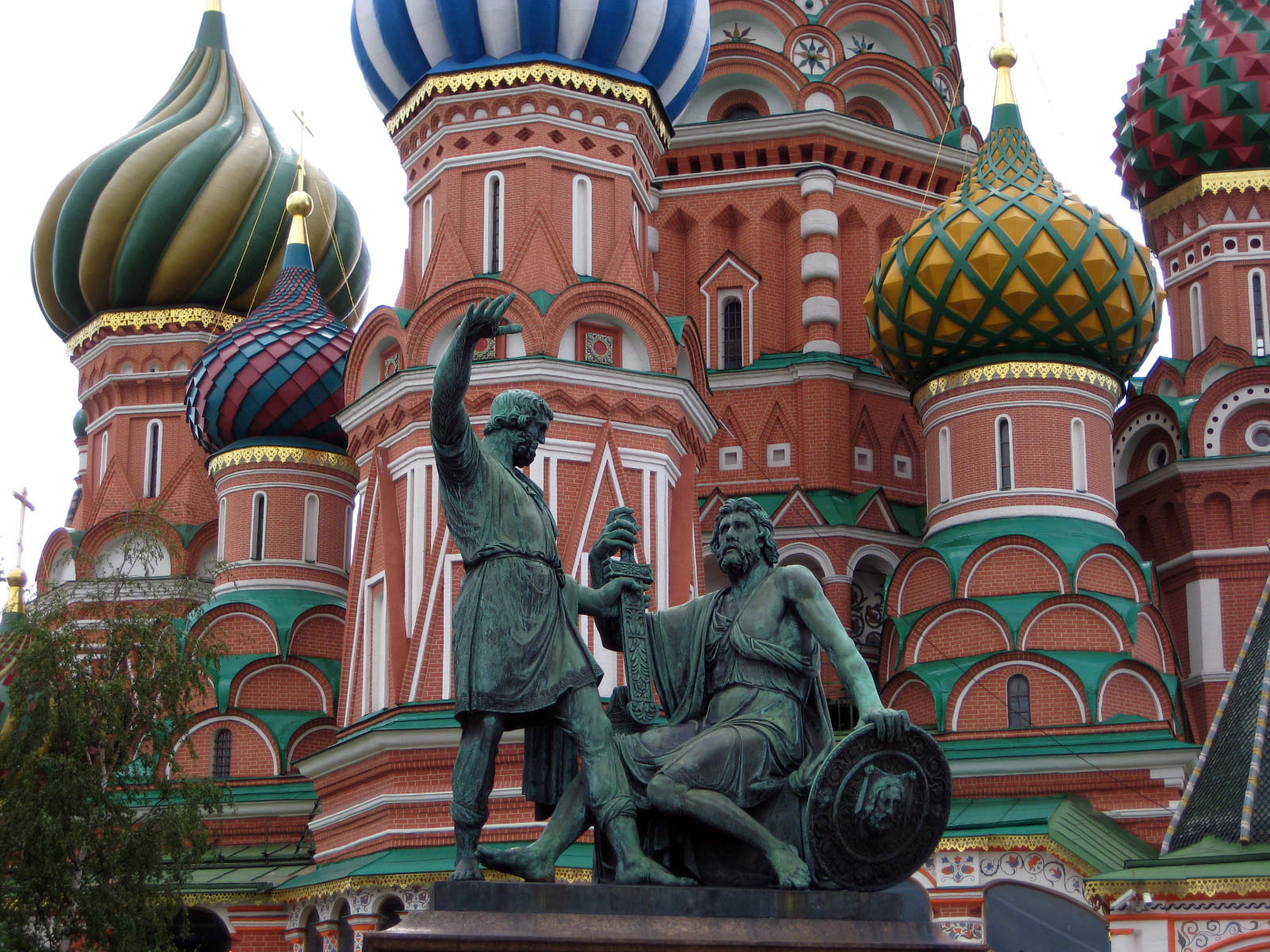
It’s been 15 years since Soviet Union folded. When we were in St Petersburg over 7 years ago, the favorite t-shirt had a statue of Lenin being pulled down with the caption reading “the party’s over”.
We had no idea what to expect. We’ve been reading and hearing tales of Russian mafia, corruption, tacky discos, big casinos and strip clubs. About 15 years ago we met the US representative to the Moscow office of the World Bank. Her daughter told of one nightclub where naked men and women swam in underwater wall-to-wall fish tanks that covered the perimeter of the club.
And so, there we were at Moscow’s Sheremetyevo airport, surrounded by bear sized taxi drivers offering “best price” to the city.
Our guide Elena arranged for her driver to pick us up and although it took a few minutes to find him, our new friend Yuri was soon leading us through the crowded terminal, the crowded parking lot and into his spacious Ford minivan.
As we drove in, I thought we were driving into New York. Yuri told us everyone says this; “Moscow, New York, Broadway. It’s all same.”
Between 1947 and 1953, Stalin built his version of New York Skyscrapers, now known as the “Seven Sisters”. Eight of them were planeed to commemorate the 800 years of Russia but the last one had too many problems. On one hand they are beautiful buildings that look like they could fit nicely around Central Park. On the other hand, they were built by thousands of gulag and war prisoners. Russia has a lot of sad history.
We spent 4 nights and 3 full days in Moscow. Two of them with our guide, Elena Mikhaylova, and one on our own. Elena is a most amazing guide; tall, attractive, young, energetic, cultured, intelligent and a great resource of Russian History and Russian art. If you have plans to go to Moscow, I hope she’ll still be guiding tours.
We’re staying at the The Golden Apple Boutique Hotel. The staff is attentive, the rooms are small and the disco music in the lobby bar is loud. The location is great.
We’re two blocks from Pushkin Square, a popular gathering place under the statue Aleksandr Pushkin, the most beloved Russian author of all times and the father of Russian modern literature.
A few years after Peter the Great of Russia claimed Estonia as part of Russia in 1710, he placed one Abram Petrovich Gannibal as Governor of Reval (the old name of Tallinn). Gannibal was an African slave from Ethiopia. It was popular for the courts of Europe to have black servants, but when Peter heard court members claiming that dark skin people were inferior to whites, he decided to prove them wrong and adopted Gannibal, giving him a good education and good home. Gannibal became a military engineer, a Major General and eventually Governor of Tallinn. But the reason I’m mentioning him here is that Abram Petrovich Gannibal, the Ethiopina slave was the grandfather of Aleksandr Pushkin.
Pushkin Square is at the intersection of Tverskaya Street, one of the main arteries through the central city and a direct shot to Red Square and the Kremlin. It’s kind of like walking down 8th Avenue in New York City. Actually the streets of Moscow are a bit wider than American city avenues. The only problem we discovered with the size of the street is that there are no crosswalks; all correspondences to the other side are through enormous underground passages where one wrong turn and you could end up a few blocks away by the time you come up to the surface again.
 One of the first stops we made was to the Yeliseyevsky Grocery on Tverskaya Street. This once noble palace was turned into a turn of the century Tsarist grocery store a few years back. You can almost see the royals buying their smoked fish and blinis here. It’s near our hotel and it is also opened 24hrs a day, every day of the week. We ended up here as often as we could.
One of the first stops we made was to the Yeliseyevsky Grocery on Tverskaya Street. This once noble palace was turned into a turn of the century Tsarist grocery store a few years back. You can almost see the royals buying their smoked fish and blinis here. It’s near our hotel and it is also opened 24hrs a day, every day of the week. We ended up here as often as we could.
Elena then took us on a short detour off the Tverskaya, to walk by some of the Moscow theatres. It’s not Broadway, but there are a lot of theatres in this city. However, with the exception of a Russian version of ABBA’s Mamma Mia, the rest was all Russian drama.
The Bolshoi Theatre is getting a makeover and all of its performances are now slated for the smaller Maly Theatre across the street. Maly means small. Bolshoi means big. It all makes sense when you know the language.
The $585 million renovation is slated to be finished by 2008, but after inspections in the basement, they discovered the damage to be a lot worse than originally thought. It could take a few more years.
The Bolshoi hasn’t had a good overhaul since it’s opening in this building in 1825. It was quickly repaired after the fire damage of 1853 and patched up after a bomb exploded the roof during a World War II air strike, but what is happening now is a complete overhaul; exterior facades, interior and a new modern, computerized stage. Elena was wondering if they would remove the “Soviet Emblem” placed at the peak of the façade during Soviet times. She has mixed feelings about removing the Soviet markings. On one hand she says it’s good to bring the building back to their original condition but on the other hand she says the Soviet period is part of out history and we can’t just ignore it.
 Right around the corner from the theater is large, orange, foreboding KGB building on Lubyanka Street. We’ve heard of horrible things that have happened in this building. It gives a chill just to look at it.
Right around the corner from the theater is large, orange, foreboding KGB building on Lubyanka Street. We’ve heard of horrible things that have happened in this building. It gives a chill just to look at it.
The KGB is gone but the new version, FSB is still there; same police force, same people. Only now they say their main objective is protecting the people from terrorism, instead of causing the terrorism themselves.
 Krasnaya (Red) Square isn’t named for the Red Soviets as I always thought, nor it named for the red painted bricks of the buildings and Kremlin wall and the State History Museum that commands one side of the square. The other side is the onion domed St.Basil’s Cathedral, possibly the most famous building in Moscow
Krasnaya (Red) Square isn’t named for the Red Soviets as I always thought, nor it named for the red painted bricks of the buildings and Kremlin wall and the State History Museum that commands one side of the square. The other side is the onion domed St.Basil’s Cathedral, possibly the most famous building in Moscow
The word Krasnaya (red) means beautiful in Russian; Bolshoi is Big, Krasnaya is Red, Kremlin is Fort. It all makes sense when you know the language.
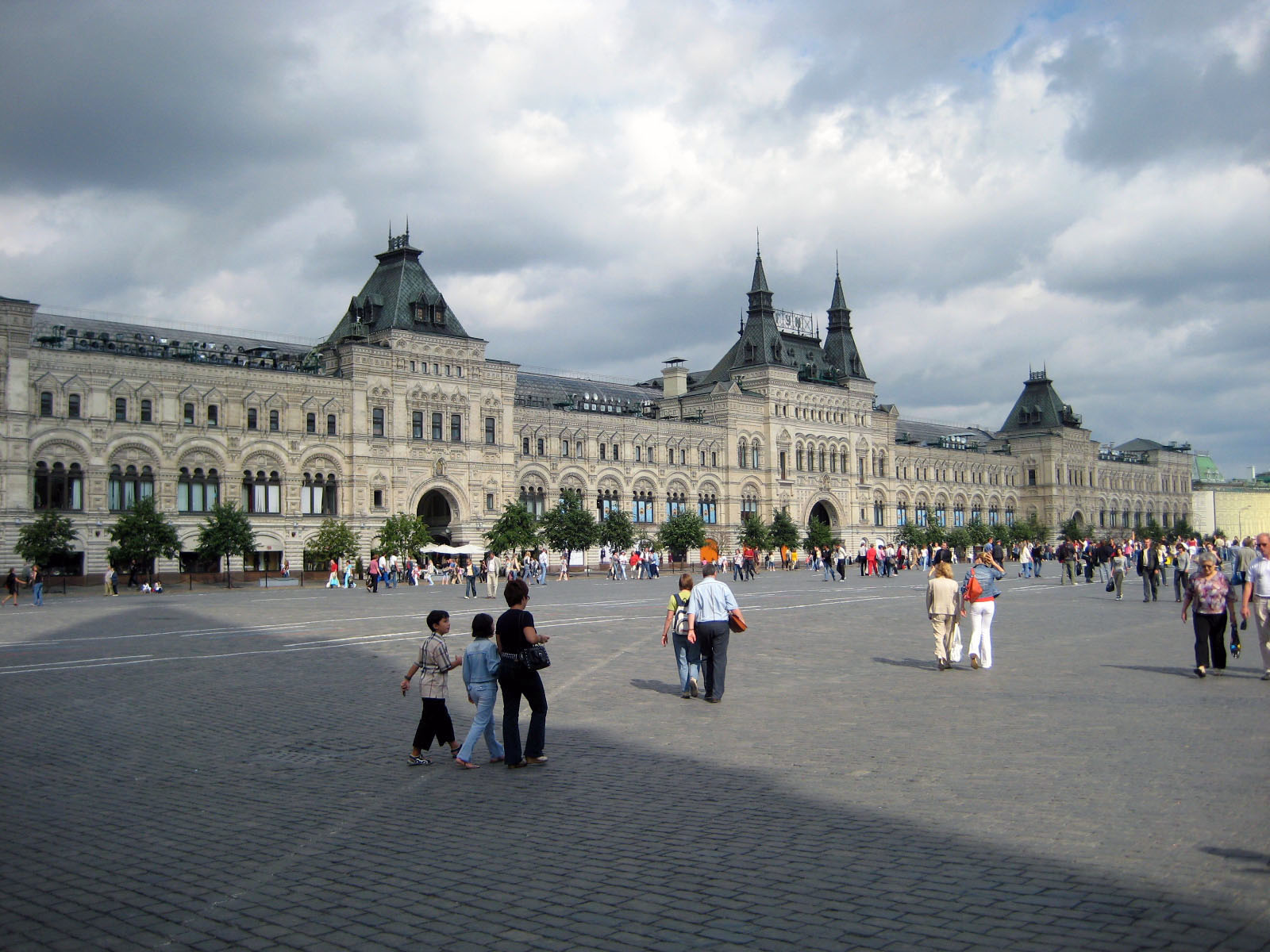 Taking up one complete side of the Square is the Gum department store (it has to be the largest department store in the world). It’s quite modern inside and looks very much like a western style mall selling all the favorite couture labels. Russians have a lot of money these days. Well, they had a lot of money durring the Soviet years too but now they’re able to show it off. They love to shop and prices are very often inflated in Moscow. Everything is expensive. That’s probably why there are so many Russian taking their shopping obsessions to other cities of the world.
Taking up one complete side of the Square is the Gum department store (it has to be the largest department store in the world). It’s quite modern inside and looks very much like a western style mall selling all the favorite couture labels. Russians have a lot of money these days. Well, they had a lot of money durring the Soviet years too but now they’re able to show it off. They love to shop and prices are very often inflated in Moscow. Everything is expensive. That’s probably why there are so many Russian taking their shopping obsessions to other cities of the world.
The other side of Red Square is the wall of the Kremlin. And in the middle of the Kremlin wall sits Lenin’s Tomb. I’ll get back to this later, since we didn’t make a visit to the embalmed body of the fearless leader until our 3rd day.
The embalmed body of Stalin used to rest beside Lenin but Khrushchev pulled him out and buried him behind the tomb in what’s now known as the mausoleum. Leonid Breznhev is also buried there, so are a few other dignified founders of the communist party, but not Khrushchev. When he was retired by the Supreme Soviet Party, his political life pretty much ended. Khrushchev was not the most eloquent or educated leaders and his public gaffs finally embarrassed him to oblivion in life and exclusion in death. However, he was a Supreme Soviet Premiere and he does have a nice memorial monument in Novodevichy Cemetery. This is the who’s who of Russia, kind of the like the Pere Lachaise of Moscow. I’ll get back to the cemetery later. Let’s get back to the Kremlin right now.
Although the first wooden Kremlin (fort) goes back to the 1100s, the walls and towers that we are looking at were designed by Italian masters between 1485 to 1495. The irregular triangle of the Kremlin encloses an area of 275,000 square meters (68 acres). The overall length of the wall is 2,235 meters (2,444 yards). No matter how big you think it is, it’s bigger.
The wall’s thickness gets up to 6.5m (21.5’) in some places. There are 20 towers, all with their own names. The tallest, known as Troitskaya (Trinity), is 260’ tall. The basement of the tower once held The 16th and 17th century dungeons. Napoleon used Trinity Tower to make his entrance into the Kremlin in September 1812. Lenin made his entrance here in 1918. These days, everyone comes through this gate.
The Kremlin is understandably a UNESCO Heritage site, although 2 buildings have been excluded from the classification, the large 1960 glass and marble Palace of Congresses (which looks way out of place) and another building built around the same time during the Khrushchev years.
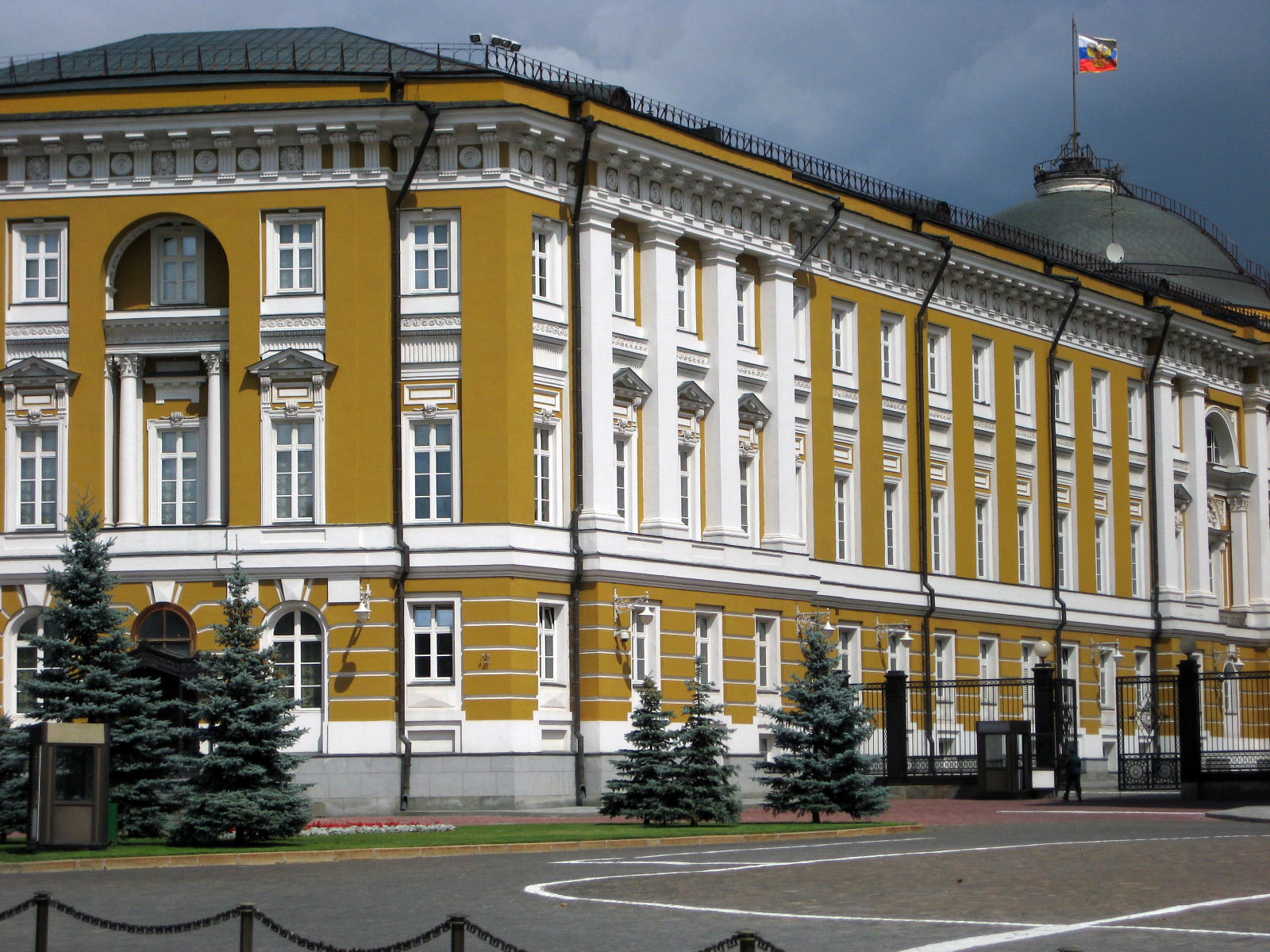 The Presidium of the Supreme Soviet serves as the offices for President Vladimir Putin and other Russian administration. This is the Russian version of the White House or 10 Downing Street. Putin uses the same office once used by Lenin, Stalin, and all the rest of the Soviet Premieres who followed.
The Presidium of the Supreme Soviet serves as the offices for President Vladimir Putin and other Russian administration. This is the Russian version of the White House or 10 Downing Street. Putin uses the same office once used by Lenin, Stalin, and all the rest of the Soviet Premieres who followed.
I’m mentioning all this because we actually saw Mr Putin, himself, coming to work. No, he wasn’t strolling across the square with a briefcase; there was a big motorcade lead by a couple of motorcycles, a hummer like security vehicles, followed by the Putin limo (his personal flag was flying) followed by 2 more hummer type security vehicles.
We told Elena how American had lost a lot of it’s refined dignity with the George W Bush administration. She laughed and told us that in one of Bush’s visits to Moscow he was chewing gum at a state dinner and when the meal was served, he pulled the gum from his mouth and put in under his state porcelain dining plate. Elena said the TV cameras captured it all and showed it on the news. I guess that one was too much for US TV coverage. We get some of them but not all of them.
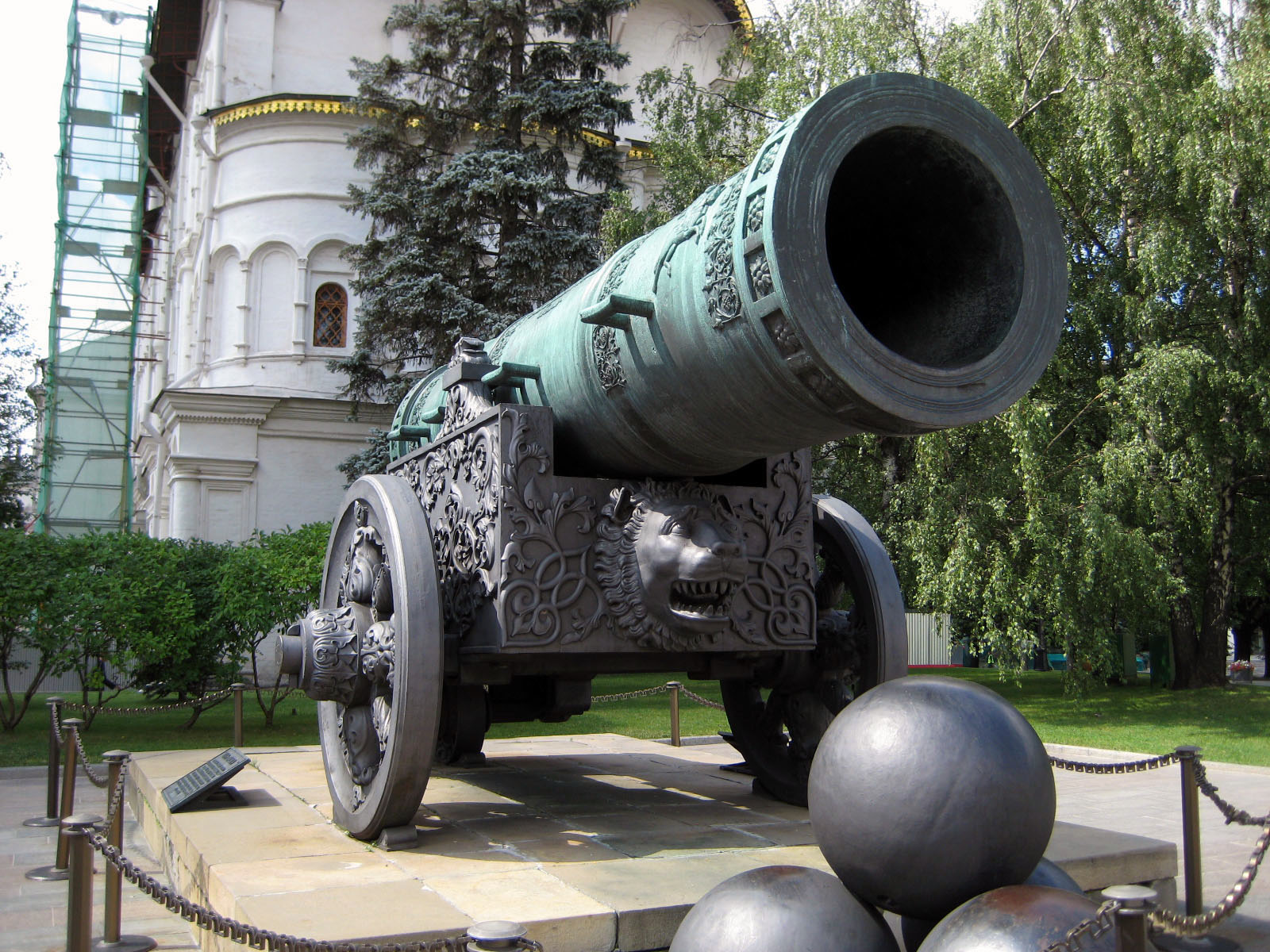 Across from the Offices of State sits the largest cannon ever made. It was created under the reign of Fyodor I, son of Ivan the Terrible in the 15th century.
Across from the Offices of State sits the largest cannon ever made. It was created under the reign of Fyodor I, son of Ivan the Terrible in the 15th century.
The Tsar Pushka (as it’s known) weighs 40 tons. It’s 17.5 ft long and has an 890 mm (35”) barrel. It was never fired. Supposedly every cannon made was tested first but when they looked into the firing chamber of the Tsar cannon, there were no traces of gunpowder. It was all for show.
 The Russians believed that bells spoke to god and so the bigger the bell the bigger the audience.
The Russians believed that bells spoke to god and so the bigger the bell the bigger the audience.
In 1733, the father-son team of Ivan and Mikhail Motorin were commissioned to create the largest bell ever made. It took them 2 years, but just as they were about to give this 200 ton beauty to the Tsarina Anna (niece of Peter the Great), a fire broke out in the Kremlin and while the casting of the bell was cooling down, the fire fighters doused it with cold water. An 11 ton chunk cracked off and now stands just below the massive creature. It never got to talk to god but still draws a lot of curious onlookers.
Cathedral Square is a short walk into the Kremlin grounds. The iconoclastic 16th century Cathedral of Michael Archangel is where 50 tombs of old Tsars and royals are laid out, some going back to the 14th century. After the reign of Peter the Great, the Tsars were buried in St Petersburg, possibly because wasn’t any more room in the Cathedral of Michael the Archangel.
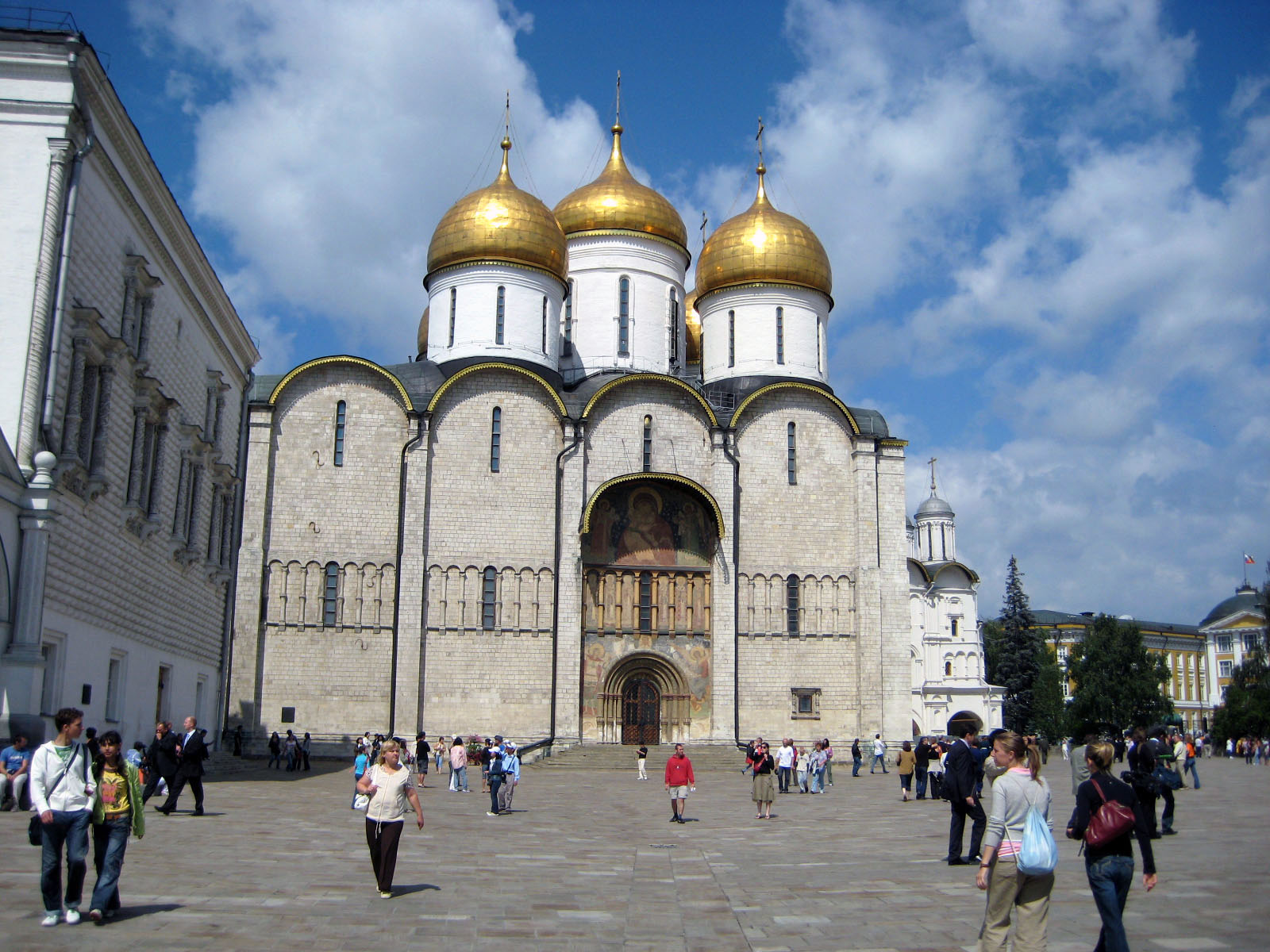 The 15th century Cathedral of the Assumption (also called the Cathedral of Domition) was built in Italian design based on Byzantine style, altered by the Russians to include smaller domes and 5 levels of iconographic art covering the interior. It’s much more of what we consider the “Russian Style” than Michael the Archangel.
The 15th century Cathedral of the Assumption (also called the Cathedral of Domition) was built in Italian design based on Byzantine style, altered by the Russians to include smaller domes and 5 levels of iconographic art covering the interior. It’s much more of what we consider the “Russian Style” than Michael the Archangel.
Ivan the Terrible, the first Tsar of Russia was crowned here in 1547. From then, every Tsar till the end of the line was crowned here. It’s not a very big church but big enough for a few very important people. During Soviet times the church was used as a playground for the children of the Supreme Soviet Premier and their friends. Now, it’s a museum.
 At 265’ tall, the 16th century Ivan the Great Bell Tower was once the tallest building in Moscow, till the construction of the Church of Christ the Savior in the 19th century. There are 21 bells in the tower, the largest weighting 64 tons.
At 265’ tall, the 16th century Ivan the Great Bell Tower was once the tallest building in Moscow, till the construction of the Church of Christ the Savior in the 19th century. There are 21 bells in the tower, the largest weighting 64 tons.
As the story goes, after Napoleon captured Moscow in 1812, he was told that the cross on the central dome of the Annunciation Cathedral had been cast in solid gold, and immediately gave orders that it should be taken down. But he confused the cathedral with the Ivan the Great Bell Tower which only had a gilded iron cross. The French engineers couldn’t figure out a way to get to the top of the tower. But then, a Russian peasant volunteered to climb the dome and lowered the cross down with a rope. When he tried to collect his reward through, Napoleon had him shot, calling him a traitor to his fatherland.
When Napoleon left Moscow in defeat during the winter of 1812, he ordered the Kremlin to be blown up. The Kremlin Arsenal, several portions of the Kremlin Wall and several wall towers were destroyed by explosions and fires damaged some of the churches. Explosions continued for three days, but the October rains damaged many of the fuses, and consequently, the damage was less severe than intended. It’s amazing the Russians still like the French.
The Armory Museum inside the Kremlin walls was once the home of the royal gold and silversmiths. Now it houses the greatest collection of riches in all of Russia. It was built as the Armory in 1508, but it was established as the first Russian Museum in 1808. It’s been a museum for close to 200 years and everything is in perfect condition. Peter the Great’s high boots look as if he just came in from a walk in the countryside. Catherine the Great’s coronation dress (with an really small waistline) looked like she just wore it last week. On display is the Throne of Ivan the Terrible and the twin thrones of Peter the Great and Ivan V; the two boys shared the throne under the guidance of their sister Sophia. After a power struggle. Sophia ended her days in the Novodevichy Convent, Ivan V went into exile, politely referred to as “private life”, and Peter became Peter the Great.
No cameras are allowed so you’ll have to make the visit to see what’s there. It is definitely worth the visit.
All the state gifts from every country in the world are here. Elena pointed out that there is more of the royal English silver in Moscow than in England.
There are royal equestrian costumes fitted to taxidermed horses; even the stuffed horses are in great condition. They’re taking extra care of the taxidermed critters because they know if the hides go bad, they’ll have to replace them with bad looking fiberglass replicas.
There is a large hall filled with coaches and covered sleds. The Tsarina Elizabeth (1741-1762) used over 100 horses to pull one of the covered sleds to Moscow from St Petersburg for her coronation. She just couldn’t wait to be the Empress. We don’t really know too much about Elizabeth except that she loved to throw extravagant parties and spend as much of the royal treasury as she could on her stately homes.
There is a case of Fabergé eggs, of course, ten of them are here. A Russian businessman named Viktor Vekelsberg bought 15 of them a couple years ago from the Malcolm Forbes collection. There were 60 of them created. Eight of them are missing.
The two floors of treasures took close to 3 hours to see and we went through at a good pace. We were fortunate there weren’t more people in the museum. It would have taken a lot longer.
At the end of the Armory is the greatest treasure of all, The Diamond Fund; the most unbelievable collection of gems ever assembled. The first room is literally filled with buckets of diamonds, sapphire, emeralds, rubies, acquamarine, spinel, chrysolite and a bunch of other gems I can’t remember. One of the diamond cases held 6 kilograms (13.2 lbs) of diamonds ranging from 5,10,15, 20 and 25 carat. Anything over 25 carats got a name, and there are a lot of names. The largest uncut diamond known as “XXIV Congress” is 349.50 carats. It’s big. There is also a 42 carat diamond that was naturally cut when it came out of the mine. It’s spectacular.
A few cases show necklaces designed by world-renowned jewelers in the 1960’s using stones from the Diamond Fund. These designs have never been copied or photographed. There are no books, no photos, no records. If you want to see them, you have to go to Moscow. It’s all very secretive. In fact when I was writing down some of facts Elena was telling me a guard was about to confiscate my notebook. He told Elena I was a threat, possibly planning a robbery. A nice idea, but highly unlikely.
Half of the first room is dedicated to gold and platinum nuggets. One of the nuggets weighs 36 kilograms (79.2 pounds). We’ve never seen anything like this in our life. And then there were some 99.9% pure gold bricks thrown in. During World War II, the Soviet Union gave Britain 265 bars of gold in payment for war supplies. Unfortunately the ship carrying them went down before the gold was delivered. In 1980, a salvage company discovered the treasure and the gold was split between Russia and the UK. However, only 260 bars accounted for. The missing 5 bars of gold has become a great mystery to both sides of the story.
The second room houses the original crown jewels. The coronation crown of Catherine the Great is here. It was the crown used for her coronation and every coronation after her. The crown is topped with a red spinel (which looks like an enormous red ruby), the orb is topped with a blue sapphire and the scepter is crowned with a 189 carat diamond that was given to Catherine by her lover Count Orloff on her name day. Most people just buy their sweethearts flowers. The red, blue and white stones make up the color of the Russian flag.
After a visit to the Kremlin we had to go back to the Hotel. We were wiped out.
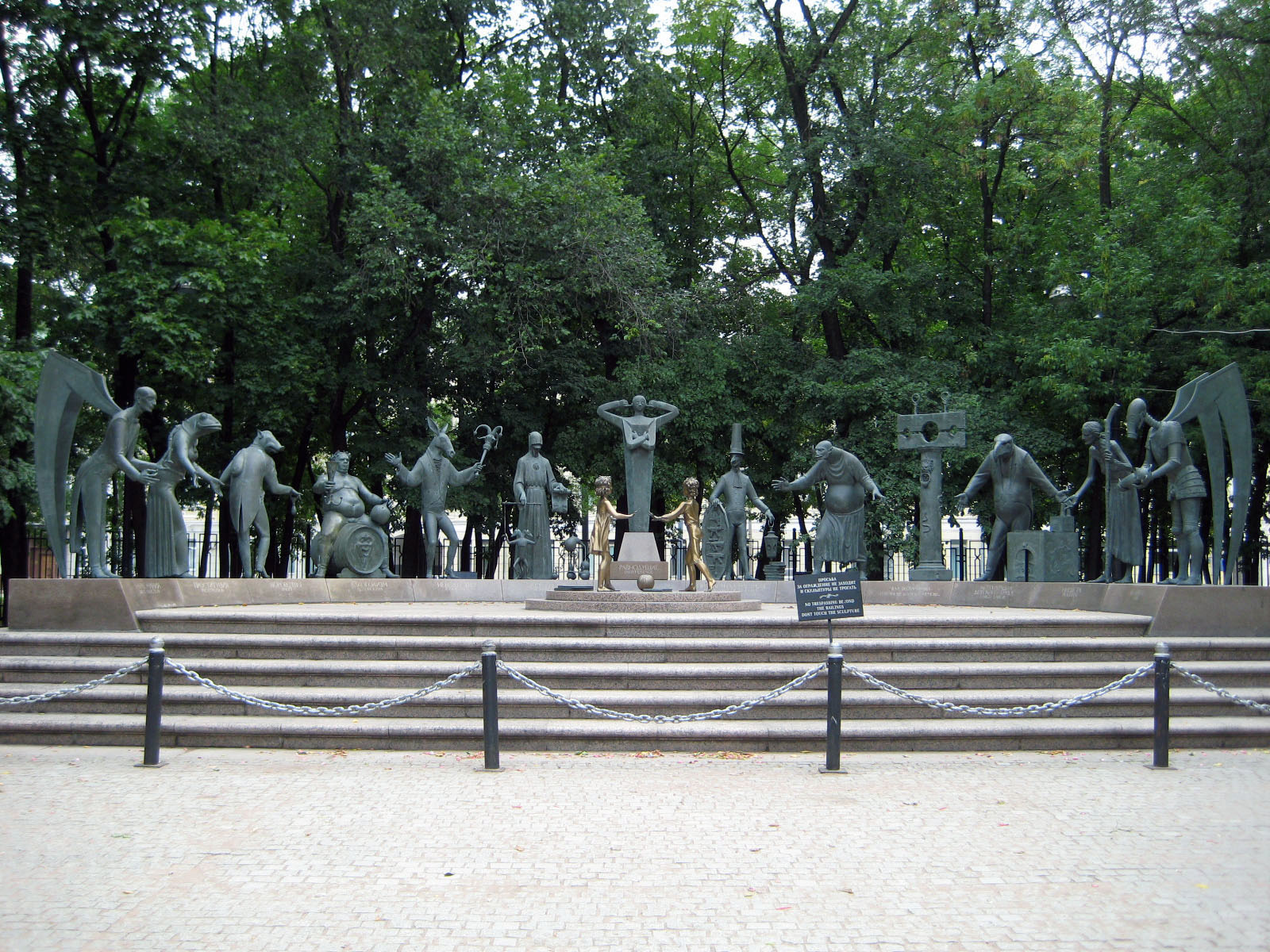 The next day we made a few short stops to see Tolstoy’s home and some city sculptures; an ensemble of 13 vices and 2 blind children by Russian artist Mikhail Mikhaylovitch Shemyakin. The point of the artist was to show how children are blind to the cruelty and vices of their parents. Nearby is a gift from Barbara Bush to Moscow of some waddling brass ducklings from the children’s story “make way for ducklings”.
The next day we made a few short stops to see Tolstoy’s home and some city sculptures; an ensemble of 13 vices and 2 blind children by Russian artist Mikhail Mikhaylovitch Shemyakin. The point of the artist was to show how children are blind to the cruelty and vices of their parents. Nearby is a gift from Barbara Bush to Moscow of some waddling brass ducklings from the children’s story “make way for ducklings”.
Elena told us the ducks were a big hit with the children of Moscow. The little brass ducks are placed across the street from the Novodevichy Convent, the most famous convent in Russia. This is the place where all unwanted royal women ended up.
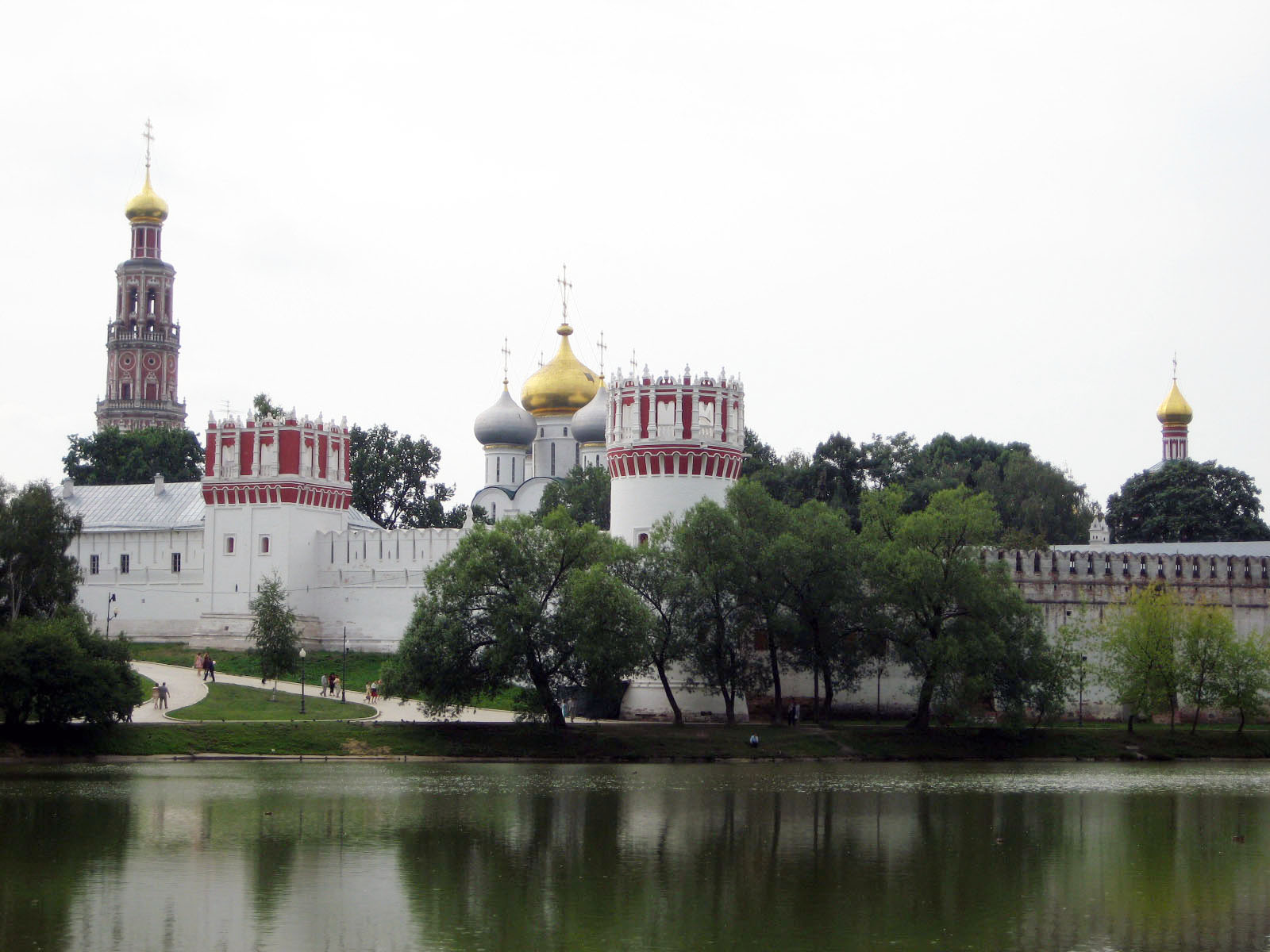 Sophie Alekseyevna, the older step-sister of Peter the Great tried to keep the throne for herself but instead spent the rest of her life here; so did Peter’s first wife, Eudoxia.
Sophie Alekseyevna, the older step-sister of Peter the Great tried to keep the throne for herself but instead spent the rest of her life here; so did Peter’s first wife, Eudoxia.
Peter eventually married Martha Skavronskaya, a Lithuanian daughter of a gravedigger and prostitute in the service of his officers who became the Empress Catherine I. Peter had a great way of pissing off the Russian nobility.
Tsar Fyodor I’s wife, Irina Gudonova (brother of Boris Gudonov) was here. In fact, Boris Godonov spent his childhood here. In Tolstoy’s “War and peace”, his central character Pierre Bezukhov was sentenced to be executed inside the Novodevichy Convent walls after his botched attmept to assasinate Napoleon (he was later freed by a Russian liberation gang.)
During the Soviet times it was made into the Museum of Women’s Emancipation. In 1994, the nuns came back, but they’re currently sharing the grounds with the Museum.
Close by Novodevichy Convent is the Novodevichy Cemetery, a veritable “who’s who” of Russian celebrity since 1898. Anton Chekhov is here, so is Tolstoy. Film director Sergei Eisenstein, writer Nikolai Gogol and politicians Andrei Gromyko (known in the west as “Comrade Nyet”) and Vyacheslav Molotov are all joined together in the hereafter here. The famous anarchist Kropotkin is here, so are composers Sergei Prokofiev and Dmitri Shostakovich, so is the film director, Mikhail Romm (who might be a distant relative of mine).
Nikita Khrushchev is one of the big stars of the grounds. Elena said a while back she saw an elderly woman sitting at the grave of Khrushchev, telling him how everything has gotten so bad we really need him to come back and straighten it all out.
 One of the most moving monuments is of Yuri Nikulin, clown and actor. A bronze figure of Yuri sits on a concrete curb with a lit cigarette as his favorite dog stretches out front of him.
One of the most moving monuments is of Yuri Nikulin, clown and actor. A bronze figure of Yuri sits on a concrete curb with a lit cigarette as his favorite dog stretches out front of him.
The list of celebrities keeps growing, New member to the grove include Mstislav Rostropovich, Gherman Titov (the second man in space), Raisa Gorbachyova, former “First Lady” of the Soviet Union and the last Soviet Premiere, Boris Yeltsin. I’m sure there is a nice spot waiting for Mikhail Gorbachev next to his wife.
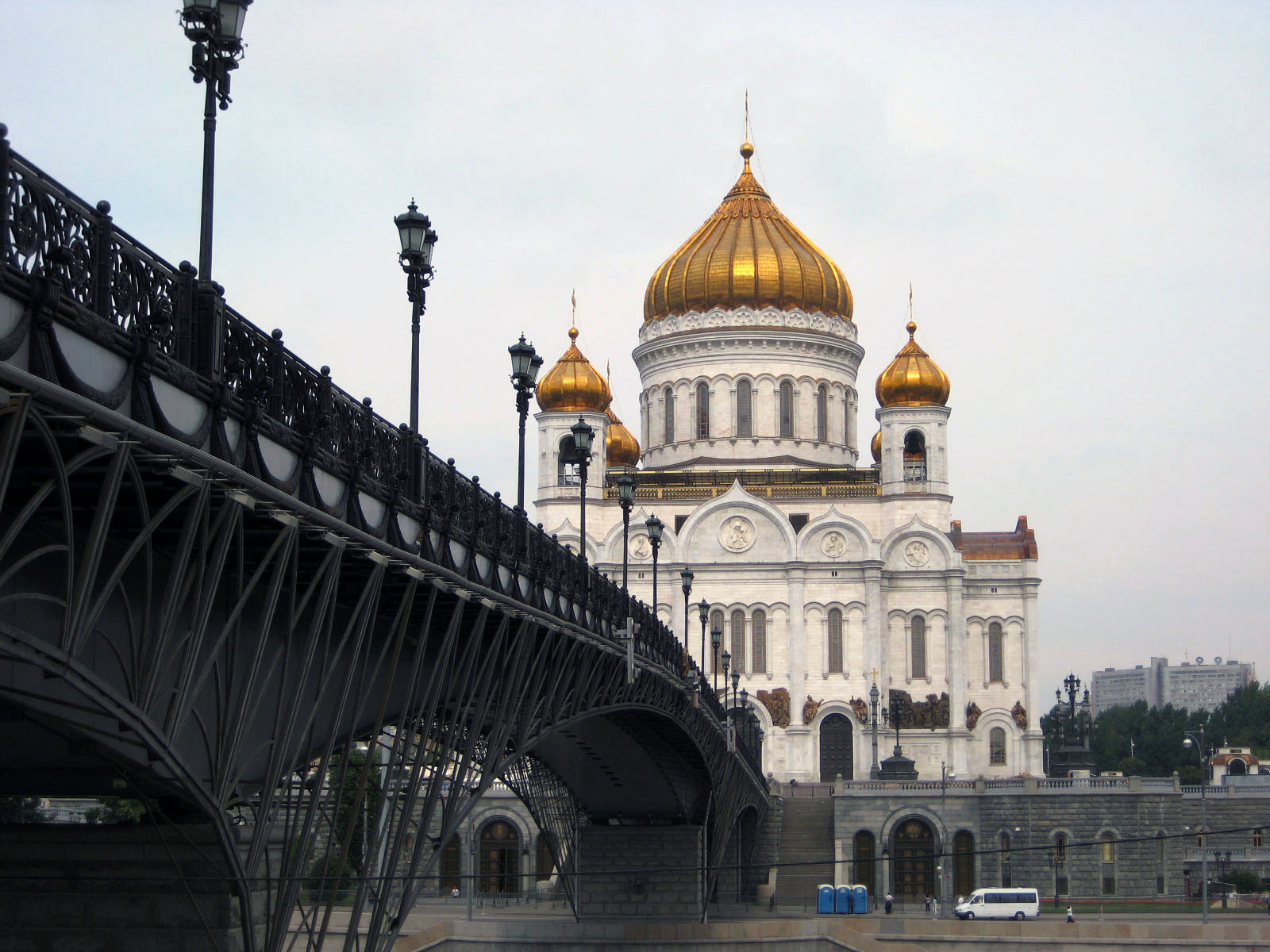 “When do you think this bridge was built?” Elena asked us as we stood looking up at the iron pedestrian bridge leading to the Church of Christ the Saviour. “Maybe late 1800’s” we guessed. “No,” Elena smiled. “It was just finished in 2004.”
“When do you think this bridge was built?” Elena asked us as we stood looking up at the iron pedestrian bridge leading to the Church of Christ the Saviour. “Maybe late 1800’s” we guessed. “No,” Elena smiled. “It was just finished in 2004.”
It’s a very good reproduction. But then, so is the Church of Christ the Savoir.
After Napoleon’s soldiers left Moscow, Tsar Alexander I signed a proclamation on December 25, 1812, declaring how he had saved Russia from the French doom, and as a memorial to the sacrifices of the people he would build the Great Church of Christ the Savior.
It’s difficult to say if the Russians defeated Napoleon through any great military strategy, but they did starve him out by burning most of the city to the ground. Talk about sacrifice.
The French were forced back west. There was no food or shelter. The only way back was the way they came in. Only this time, the Russian winter had set in. They were tired, beaten and almost dead, begging the Muscovites for food, holding out their hats saying “cher ami, cher ami” (dear friend). But the Muscovites gave them nothing. There is a common word in the Russian language, “cheramika” which means really poor or sloppy looking. It’s origin is from how poor and desolute the French soldiers were as they pleaded “cher ami” on they way out of town.
Around the same time, the French adopted a Russian word. When the Russians came to Paris as part of their occupation of the city in 1814, they were appalled by the slow service in the restaurants and kept on shouting “bistrot, bistrot” (bring it faster). Eventually the fast service got popular and these days Bistro’s are all over France.
Alexander I’s memorial church would be the tallest and largest Eastern Orthodox Church in the world. The declaration might have been in 1812, but the completion and consecration wasn’t until 1883. There were a lot of difficulties and setbacks; bad design, the foundation sank in the original swampy location, new designs, new location on the banks of the Moscow river, lack of funds. Finally, on the day Tsar Alexander III was crowned, May 26, 1883, the Church was consecrated at it’s current position along the Moscow River. One year before, in 1882, Tchaikovsky debuted his 1812 Overture here.
Then, on Dec 31, 1931, under the orders from Stalin, the Church was demolished, reduced to rubble in just a day. Stalin wanted the site for his Palace of Soviets, a proposed 415 m (1,317’) tall wedding cake style skyscraper crowned with a giant statue of Lenin. But the project ran out of money and had too many logistical problems. In 1958, Khrushchev turned the round foundations of the site into a large 129.5m (427’) diameter circular open air swimming pool, the largest in Europe.
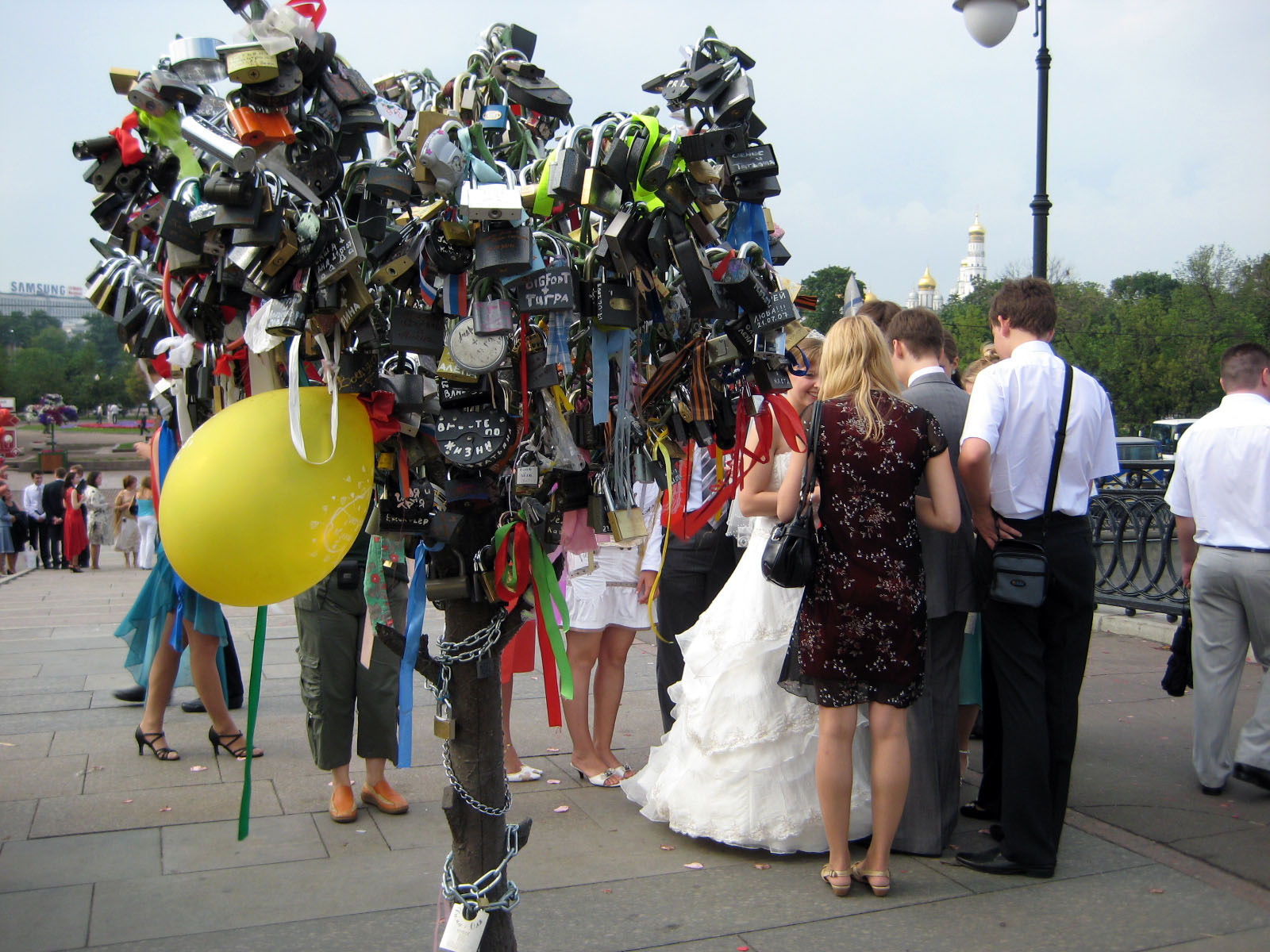 In 1995, the cathedral was rebuilt exactly as it looked before Stalin; same plans, same materials. It was completed in August 2000. The pedestrian bridge across the Moscow River was completed in 2004. It has since become a “must” stop for the weddings of Moscow. The railings are decorated with padlocks and on there is a lock tree (the cluster of padlocks to the left) in the center of the bridge. Lovers and newly wedded close the lock on the tree or the railing and then thrown the key into the river, signifying either the strength of their love or there is no way out.
In 1995, the cathedral was rebuilt exactly as it looked before Stalin; same plans, same materials. It was completed in August 2000. The pedestrian bridge across the Moscow River was completed in 2004. It has since become a “must” stop for the weddings of Moscow. The railings are decorated with padlocks and on there is a lock tree (the cluster of padlocks to the left) in the center of the bridge. Lovers and newly wedded close the lock on the tree or the railing and then thrown the key into the river, signifying either the strength of their love or there is no way out.
We’ve seen a lot of weddings all over the city. If you can’t see them you can surely hear them. The wedding party (in rented limousines) will drive to 20 favorite stops along the city. At each stop, they toast a bottle of champagne, which prompts the wedding entourage to yell “gorka, gorka, gorka (bitter, bitter, bitter). This is the cue for the bride and groom to kiss and sweeten the bitterness.
We moved on to a tour of the Tretkakov Art Gallery, the best collection of Russian art in the city, most likely in all of Russia and quite possibly in the world. It’s also the best education anyone can get on how great these artists were and still are. Each room is dedicated to a different talent.
There is Karl Briulov (1799-1852) room, known for his neoclassical and romantic themes. He’s probably the first Russian painter to ever achieve international acclaim. There’s the room of Vasily Tropinin (1776-1857), who spent most of his life as a serf until his self taught style of romanticism bought his freedom at age 40. His trademark smirk is on all his subjects’ faces. We learned about Vassily Perov (1834-1882) one of the fathers of the Russian impressionist movement and a founding member of Peredvizhniki, a group of painters who shunned academic teaching and formed their own traveling exhibit cooperative, kind of like the Impressionists of Paris. One of the most famous of the Peredvizhniki painters is Ilya Repin (1844-1930). His ability to show the stress of social decay and disorder made him a favorite of the Soviets.
Every one in a while we play the game “if you could have you portrait done by any painter, who would it be?” Gretchen chooses Repin.
One of my favorites was Viktor Vasnetsov (1848-1926) who painted the fairy tales and myths of Russia including the stories of the Bagatyrs (the old Russian Superheroes). He also painted one of the most famous portraits of Ivan the Terrible. Another personal favorite was the room dedicated to Vassily Vereshchagin (1842-1904) a reporter who painted some of the most astounding antiwar canvases we’ve ever seen.
After a good Russian lunch of meat pies, kasha and soup, we said our goodbyes to Elena. I love the restaurants in Moscow just because they’re spelled “PECTOPAH” It’s fun to say, let’s go to the PETOPAH” for dinner.
We were on our own, unchaperoned in Moscow. Elena gave us a short list of things she’d recommend and the rest was up to us.
Our first stop was the old Arbat street. We heard this was a big marketplace filled with souvenirs, crafts and buskers playing music in the street. Sounded like a San Francisco street fair.
What we found was overpriced souvenirs and a large following of Hari Krishnas. We haven’t seen many of them since they were booted out of the airports. But they’re still signing and dancing and giving away the same book. We walked the length of the pedestrian zone and then took the metro back to Pushkin Square. Elena told us to bargain with the shop keepers but when they started the bid at 600 roubles ($24) for a really cheap t-shirt I couldn’t even get into the game.
The Metro (or Mempo in Russian) is one of Moscow’s greatest treasures. At 17 roubles ( 66¢) for a one way ticket, it’s one of the best deals in the city and over 6.8 million people each day agree. We made our visits on Saturday and Sunday when the traffic is a more manageable. Each metro line is represented by a number and a color. That’s the easy part.
Every Metro station is a work of art and it’s fun to just get off one train, have a look around and get back on the next one; there’s another train every 90 seconds. Getting into the metro usually takes at least a 5 minute escalator down to reach the tracks. It’s an ear popping really steep descent.
Trying to figure out where you’re going is also a lot of fun. The metro map might be written in Cyrillic and western lettering, but the Metro signs are all in Cyrillic. That’s not too bad, it’s like matching one picture to another. But then figuring out which direction to take can be really confusing, but we soon found out the secret. If the train is going away from the center of the city, a male voice will announce the next station. If the train is heading towards the center of the city, it’ll be a female voice.
I still think it would be a lot easier if they just put the name of the station on the wall like other metro systems around the world.
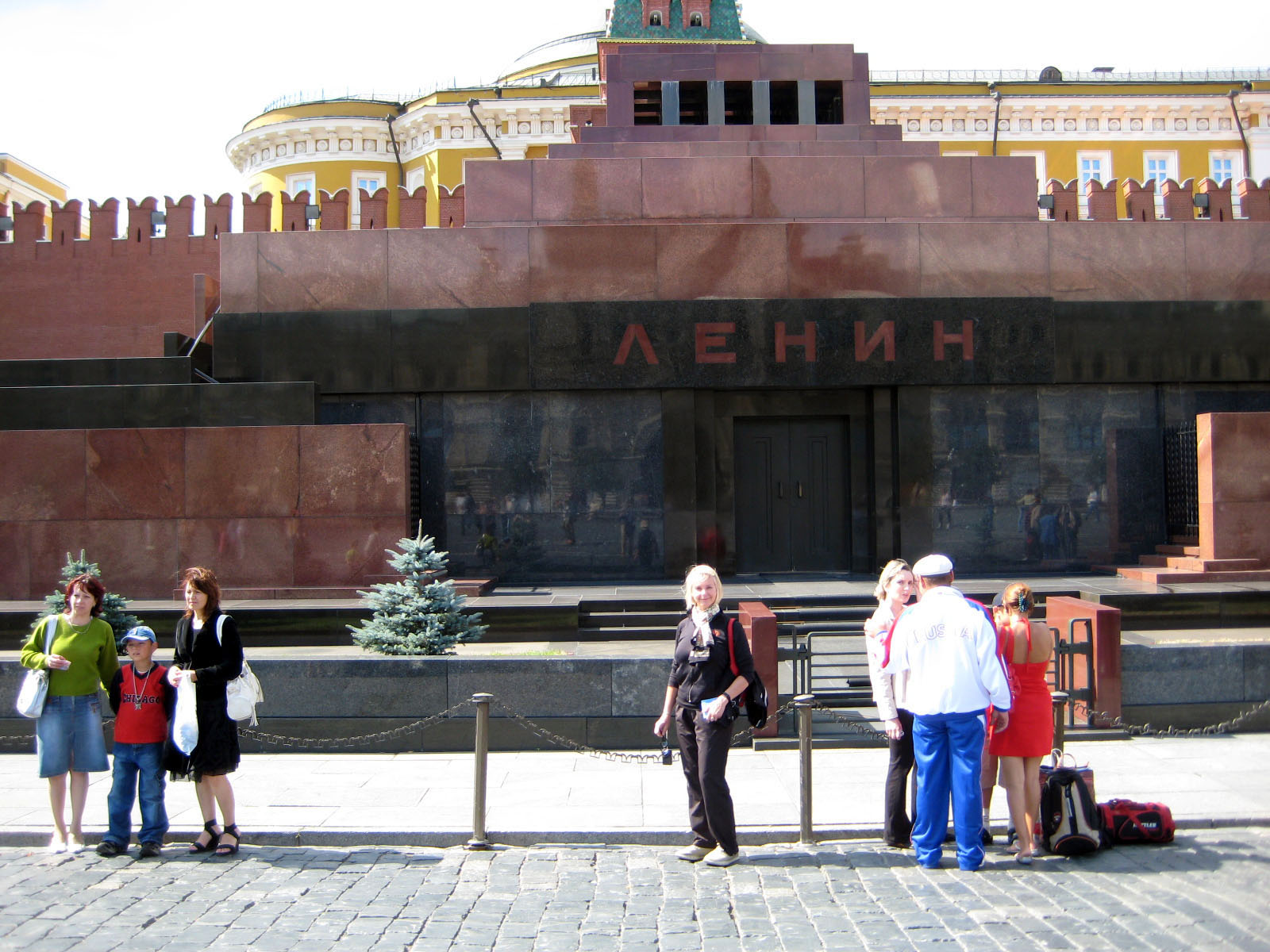 On our last day in Moscow, we arrived to Lenin’s tomb about 9:45am, 15 minutes before they open for viewings. Elena told us there’d be big lines but we thought 10-15 minutes early would be enough time. We were Wrong. This is the biggest “must see” exhibit in Moscow. By the time we got to the actual line (it’s compulsory to go the wrong way at least twice in Moscow) the wait was well over 2 ½ hours. With heads lowered in disappointment, we walked away. But within 10 steps, a woman with a tour guide badge asked if we’d like to bypass the line and see Lenin. You bet… The price she quoted was 40 euros for the both of us (700 roubles). We tried to bargain but she responded, “I have to pay the guards a lot of money”. And so we gave her the money, she walked up to the front of the line, the guards nodded and we passed through. Ah, Russian corruption at it’s best.
On our last day in Moscow, we arrived to Lenin’s tomb about 9:45am, 15 minutes before they open for viewings. Elena told us there’d be big lines but we thought 10-15 minutes early would be enough time. We were Wrong. This is the biggest “must see” exhibit in Moscow. By the time we got to the actual line (it’s compulsory to go the wrong way at least twice in Moscow) the wait was well over 2 ½ hours. With heads lowered in disappointment, we walked away. But within 10 steps, a woman with a tour guide badge asked if we’d like to bypass the line and see Lenin. You bet… The price she quoted was 40 euros for the both of us (700 roubles). We tried to bargain but she responded, “I have to pay the guards a lot of money”. And so we gave her the money, she walked up to the front of the line, the guards nodded and we passed through. Ah, Russian corruption at it’s best.
But before we could get into the tomb, we had to deposit our cameras and cell phones, another 90 roubles for the storage fee. There is no charge to see the body of Lenin, but they sure have figured a good way to make it profitable.
There we were, down to one metal detector, two security guards and a short walk from one of the greatest embalming stories in history. “You must walk through quietly and you must not put your hands in your pockets”, one of the guides spoke out to the crowd of embalmophiles. Not a problem. Our hands were by our sides the entire time.
The presentation is beautiful, eerie lighting, thick red drapery and the remarkable coffin with the crystal top. And there he is, looking more like a wax replica than a real person, even though the Lenin-keepers swear it’s all him; no wax. They pull him out at regular intervals and give him a good chemical bath with the secret sauce and a fresh change of clothes. Either he had an enormous wardrobe or the Lenin-keepers have been making copies of his 1925 suit for years.
 Saint Basil’s Cathedral is one of Ivan the Terrible’s greatest architectural achievements. Like all churches in Moscow, it was built to commemorate a great war or battle. In this case, it was built between 1555 and 1561 to commemorate Ivan’s capture of the Monghol-Tartar Khanate of Kazan.
Saint Basil’s Cathedral is one of Ivan the Terrible’s greatest architectural achievements. Like all churches in Moscow, it was built to commemorate a great war or battle. In this case, it was built between 1555 and 1561 to commemorate Ivan’s capture of the Monghol-Tartar Khanate of Kazan.
The church is dedicated to Basil, the Fool for Christ. The Russians had a great respect for crazy religious people known as Fools for Christ. Basil was an apprentice shoemaker in Moscow with a penchant for shoplifting and giving the stolen booty to the poor. He also walked the street of Moscow naked and weighed down with chains, speaking out publicly against Ivan the Terrible’s negligence of the church.
When he died (around 1557) Ivan was one of the pallbearers. Basil was canonized in 1580 and in 1588 Tsar Fyodor Ivanovich (son of Ivan the Terrible) had a chapel added on the eastern side above the grave of Basil Fool for Christ. Fyodor I was also a little out of balance and spent most of his life visiting churches and ringing their bells.
The exterior of the church is spectacular, built with 8 onion domes to commemorate the 8 days Ivan the Terrible fought to capture the city of Kazan. The interior is much smaller. It’s a labyrinth of small chapels and domed chambers. We heard a male quartet singing Russian Orthodox chants in one of the domes and it was so beautiful we bought one of their CDs. I must have been influenced by the Fool.
Legend says to make sure that they would never duplicate any aspect of this wonderful building again, Ivan the Terrible rewarded the architects Barna and Postnik by cutting off their tongues and arms and blinding their eyes.
Elena told us that yes, Ivan IV (the Terrible) was cruel and it was true that when he was 13 yrs old he threw Prince Andrew Shuisky, the head of the boyars who usurped his throne, into a cell with a pack of starved hunting dogs. He was also known to throw cats and dogs from the Kremlin walls and, even though it was an accident, he did beat his son to death with his walking cane.
But Ivan was also a great statesman, great builder and a very fair and just ruler. The Russians refer to him as Ivan Grozny, which could mean either Terrible or Awesome. She also gave us the paradox that Tsar Peter I was called “the Great”, yet he also had his son tortured and killed, imprisoned his sister, dragged his first wife, Eudoxia from her bed and charged her with adultery, had the brother of his mistress drawn and quartered and was pretty brutal to all his enemies. The title of “The Great” might have just referred to his height. At 6’8” tall, he was a giant of a man for the late 1600’s.
Pushkin Museum
We almost got to the site of Troy when we were in Turkey. We were about 60 km away and gave up. We figured there was really nothing there except some markers where things used to be. The real treasure of Henrich Schliemann’s Trojan dig was here in Moscow at the Pushkin Museum. Schliemann smuggled the treasure out of Turkey in the late 1800’s and gave it to the Pergamon Museum in Berlin. During the war, the Russians took it and brought it back to Moscow. There’s been a tug of war between Turkey, Russia and Germany for years, but for now, it’s here at the Pushkin.
And so we paid our entrance fee of 600 roubles (about $24) and then found out the Troy exhibit was closed.
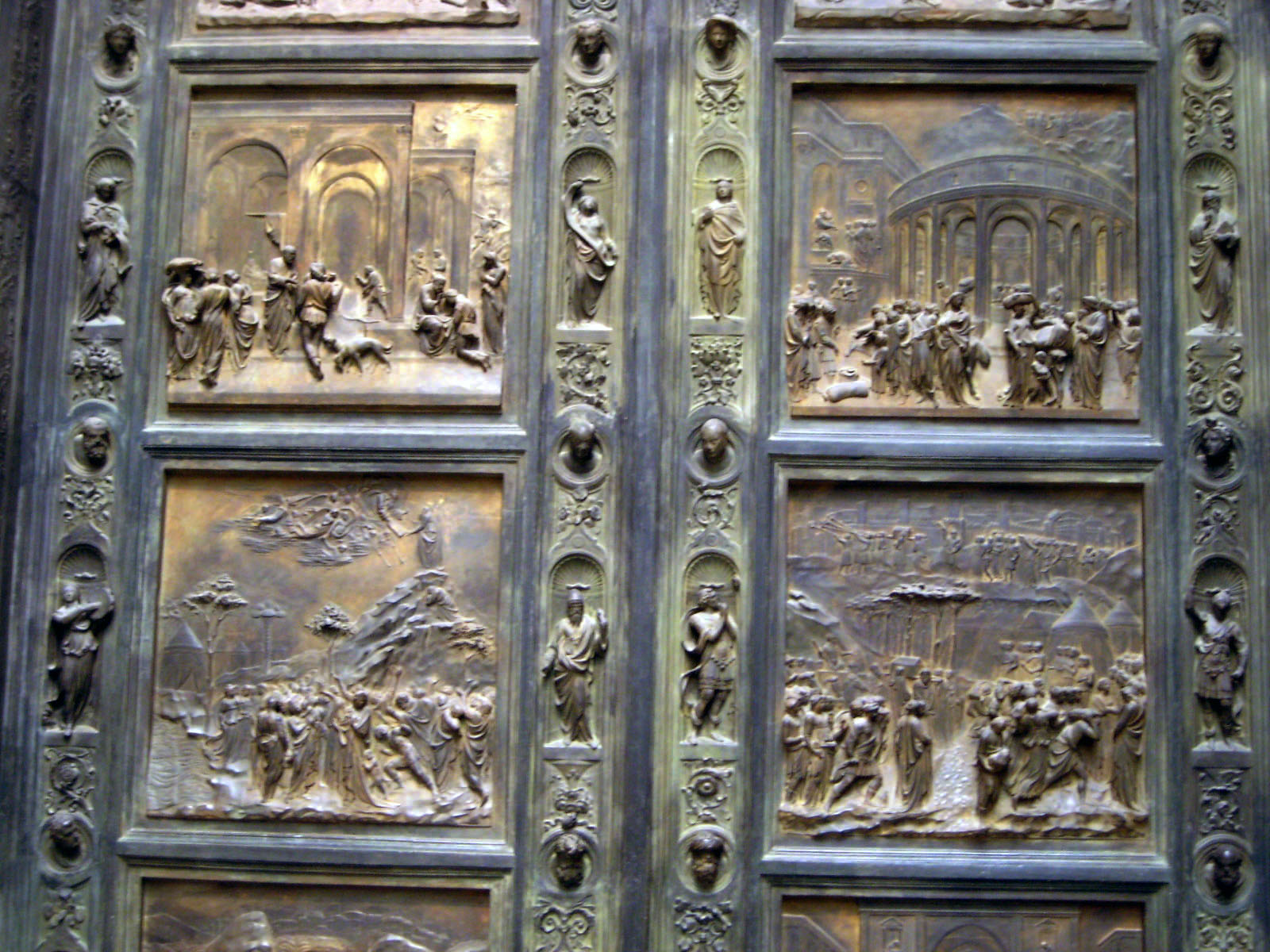 Well, we already paid the admission, might as well see what else is here. From 1889-1912 Russia sent great masters all around Europe to make copies of many of the greatest works of the masters, including Ancient Egypt, Classical Greek, Roman Empire, Renaissance, Gothic and Baroque. It originally started out as a museum for art students to study the masters without leaving Moscow. It turned into the greatest museum of plaster copies in the world. At first we were disappointed we weren’t going to see the Troy treasures. Then we got pissed off when we realized the museum was just a bunch of copies. Then we were amazed at how good the copies really are. One of the docents told us that in some cases, the copies are all that’s left. The originals have been destroyed. The bronze copies (made of plaster) of the Ghiberti Baptistry doors (photo above) look as good as the copies that are currently on the Florence baptistery. The Donatellos and Michaelangelos are fabulous. There are casts of wooden busts, cathedral entrances, and mosaic ceilings. It’s the best museum of fakes we’ve ever been to. Actually, it’s the only museum of fakes we’ve ever been to.
Well, we already paid the admission, might as well see what else is here. From 1889-1912 Russia sent great masters all around Europe to make copies of many of the greatest works of the masters, including Ancient Egypt, Classical Greek, Roman Empire, Renaissance, Gothic and Baroque. It originally started out as a museum for art students to study the masters without leaving Moscow. It turned into the greatest museum of plaster copies in the world. At first we were disappointed we weren’t going to see the Troy treasures. Then we got pissed off when we realized the museum was just a bunch of copies. Then we were amazed at how good the copies really are. One of the docents told us that in some cases, the copies are all that’s left. The originals have been destroyed. The bronze copies (made of plaster) of the Ghiberti Baptistry doors (photo above) look as good as the copies that are currently on the Florence baptistery. The Donatellos and Michaelangelos are fabulous. There are casts of wooden busts, cathedral entrances, and mosaic ceilings. It’s the best museum of fakes we’ve ever been to. Actually, it’s the only museum of fakes we’ve ever been to.
Each building of the Pushkin Museum is another 600 rouble ($24) ticket. Elena told us the four Renoirs in the European Art museum were really worth seeing. And yes, they are beautiful, but somehow all the French impressionists seemed out of place after all the wonderful Russian art we saw the day before.
And so, another adventure down into the belly of the metro system. We got on and off trains, walked up and down stairs, asked for directions and got answers in Russian, English and mime. We were even thrown off a train by a ping-pong paddle wielding Russian metro policewomen. Apparently we’d reached the end of the line and the train was being pulled off the grid for the rest of the day.
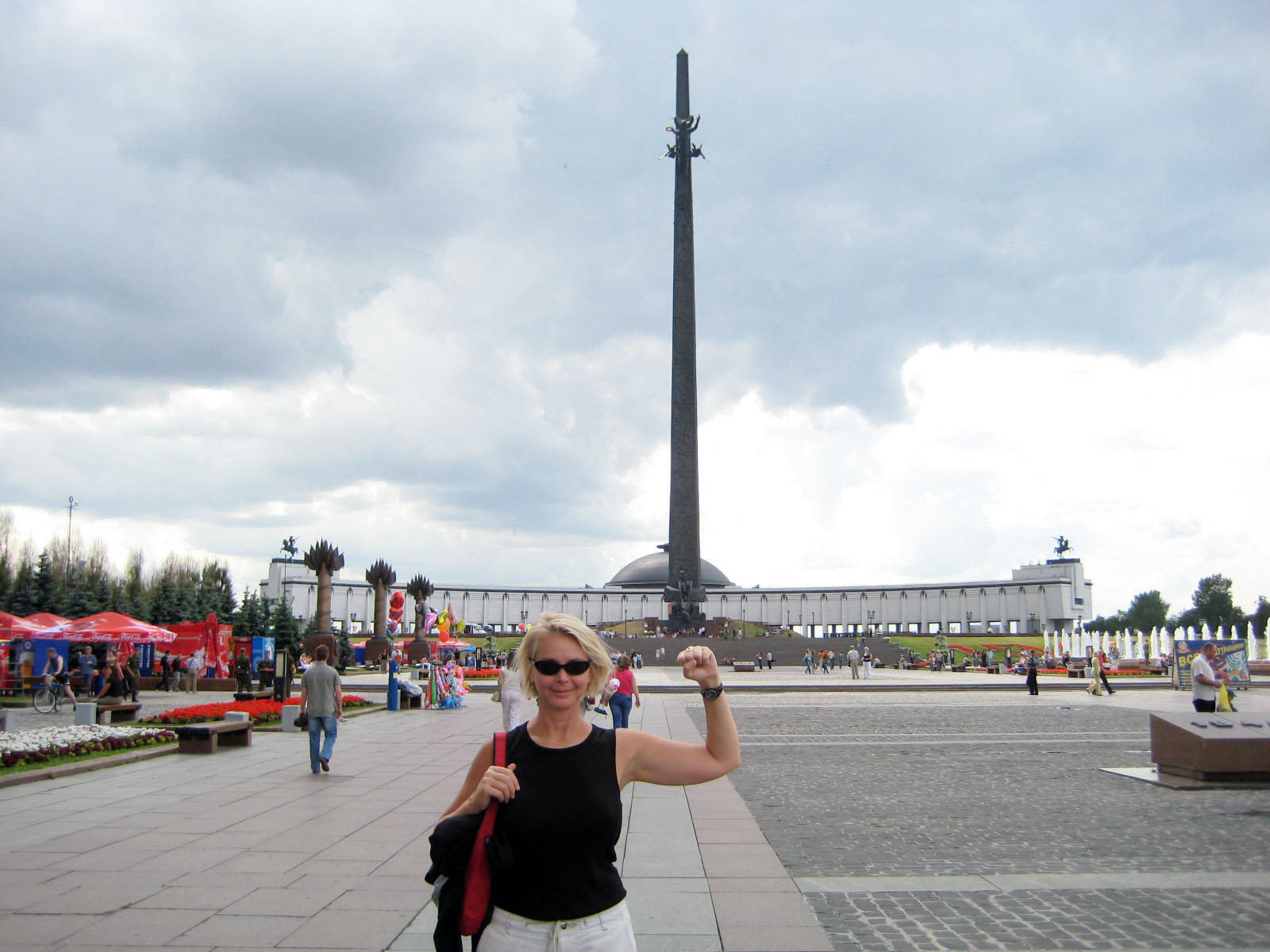 We eventually we found our way to the Victory Park, the War Monument dedicated to the 27 million Russians who died for the motherland between 1941 and 1945. I wonder how many people in the so-called Soviet Satellites were killed in the Soviets Gulags and work camps between 1944 and 1960?
We eventually we found our way to the Victory Park, the War Monument dedicated to the 27 million Russians who died for the motherland between 1941 and 1945. I wonder how many people in the so-called Soviet Satellites were killed in the Soviets Gulags and work camps between 1944 and 1960?
The monument is 141m 8cm tall, 10 cm for every day of the war between 1941 and 1945. At the base of the column is a statue of St George (the patron saint of the city) killing the dragon although it does seem a bit incongruous to see him up on the statue since the Soviets banned all religious beliefs.
The museum is a tribute to the great suffering of all great battles during the war, St Petersburg (Leningrad), Moscow, Stalingrad, Kursk and Smolensk. There are rooms like the” Hall of Sorrows” and the “Hall of Memory”. One floor is made up entirely off dioramas re-enactments of many of great battles. In the room of the Battle of Berlin, a television monitor plays an archive film of the triumphant Soviet army marching in Red Square after the fall of Berlin in 1945.
On the next floor up are cases upon cases upon cases of war memorabilia; clothing, photos, posters, models of ships, weapons, letters, speeches, more medals, more clothing, more film clips. I hit overload. Gretchen could have gone on for at least another day.
 Yuri, our driver, had taken the day off and gone to his country Dacha (cabin) to be with his wife, daughter, granddaughter and dog for the day. He came back to Moscow at 2:00am and then picked us up at 10:00am to bring us to the airport.
Yuri, our driver, had taken the day off and gone to his country Dacha (cabin) to be with his wife, daughter, granddaughter and dog for the day. He came back to Moscow at 2:00am and then picked us up at 10:00am to bring us to the airport.
On the ride he told us about his love of Russian cars and about the days when he was a 1968 Olympic hopeful in the 20 km long distance. At 59, he still keeps in great shape, running every day and after 3 days in Moscow, we were able to understand him a lot more that when we all first met.
And after he dropped us off, I asked him what he was going to do for the rest of the day. He responded, “Yuri, beer,” and then made the international symbol of going to sleep, clasping his hands, palms together to the side of his face.
You must be logged in to post a comment.